Growing up in the 90’s every dinosaur book I grew up reading liked to compare the Cretaceous dinosaur fauna of North America with that of Asia, highlighting just how similar they were. Both continents had representatives from the same major groups; dromaeosaurs, ornithomimosaurs, ankylosaurs etc. Some genera were remarkably similar, like North America’s Tyrannosaurus and Asia’s Tarbosaurus, and other genera could be found on both continents, like Saurolophus. The only major group that North America had, and Asia did not, was the ceratopsidae, the large horned dinosaurs of the ceratopsia suborder. Asia had other representatives of the group, like Protoceratops, but no large horned dinosaurs, and the books of the time loved to speculate on why that was. All that changed in 2010 with the formal description of Sinoceratops zhuchengensis, the first horned dinosaur found in Asia, and the first one found outside of North America. What we know about Sinoceratops is based on fragmentary skull material from 3 specimens. It’s not a lot to go by but it’s enough to know that large centrosaurine ceratopsians lived in Asia 73 million years ago, and that’s enough to get excited about it.
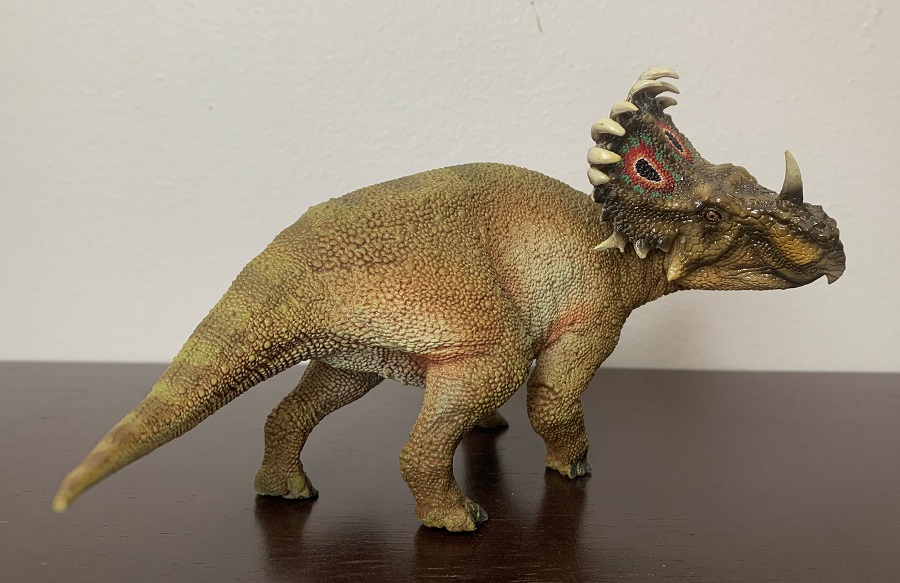
Since its discovery, Sinoceratops has been produced by toy companies a few times. The first was by Takara Tomy, for the 2012 Dino Kingdom Expo in Japan. Later, Favorite would produce one for the Fukui Dinosaur Museum in Japan, paired with a Zhuchengtyrannus. Both figures were exclusive limited releases and are now rare and command high prices. With the release of Jurassic World: Fallen Kingdom Sinoceratops would receive wider recognition. That said, the movie’s Sinoceratops is a highly stylized caricature of the real animal and although I liked the design choices it will likely influence how Sinoceratops is viewed by the public henceforth, like most dinosaurs popularized by the Jurassic franchise. In addition to the Mattel action figures Nanmu also produced a Sinoceratops in the likeness of the film’s version.
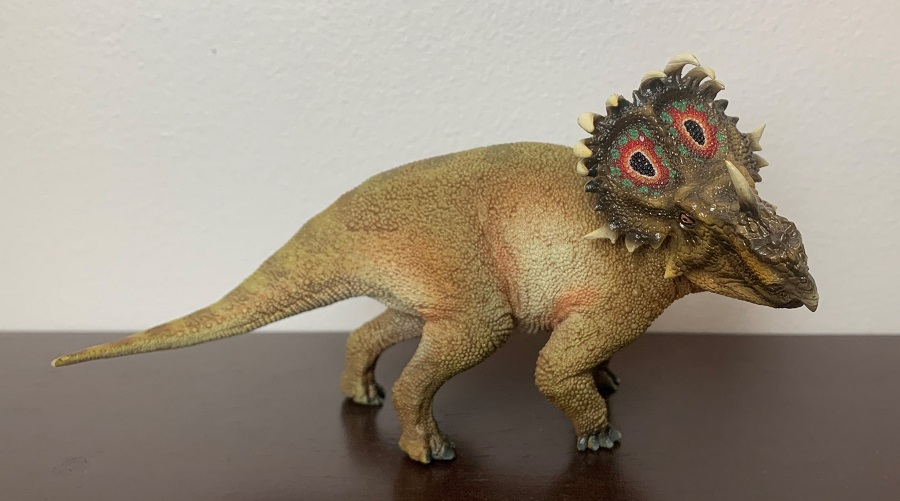
With increased popularity it seems likely that other mainstream companies will produce Sinoceratops too, and I’m sure CollectA or Safari will tackle the genus with accurate takes eventually. But PNSO has beaten them to the punch with their own Sinoceratops released in 2020, a followup to the baby Sinoceratops they also produced. Named A-Qi, the PNSO Sinoceratops is part of their mid-sized Prehistoric Animal Models line, and its the figure we’re looking at today.

A-Qi measures 6” in length and stands about 3.5” tall at the frill. The body is curved however, and if you measure along that curve the figure comes out to about 9” in length. Sinoceratops has an estimated length of 19.7-23’ which puts the figure at about 1/26 – 1/30 in scale. Another way we can calculate scale is by measuring just the head. A-Qi’s head measures 2.5” while the skull of Sinoceratops, one of the largest of any centrosaurine, measured 5.9’. Using just the head the figure comes out at 1/28 in scale.

Although we only have skull material for Sinoceratops the bodies of most ceratopsians are all quite similar and A-Qi has the typical body plan you would expect it to have. The overall form is stocky and robust. The forelimbs are slightly splayed at the elbows and five digits are sculpted on each with the last two digits being greatly reduced in size. The hindlimbs each have four forward facing toes and the tail is appropriately short. The hips are slightly visible under the skin in a realistic way and the model has a heathy and strong appearance. A-Qi is posed with the head and tail curving towards the right. The head is slightly tilted, giving the figure some personality and an inquisitive appearance that’s pleasing to look at from multiple angles.
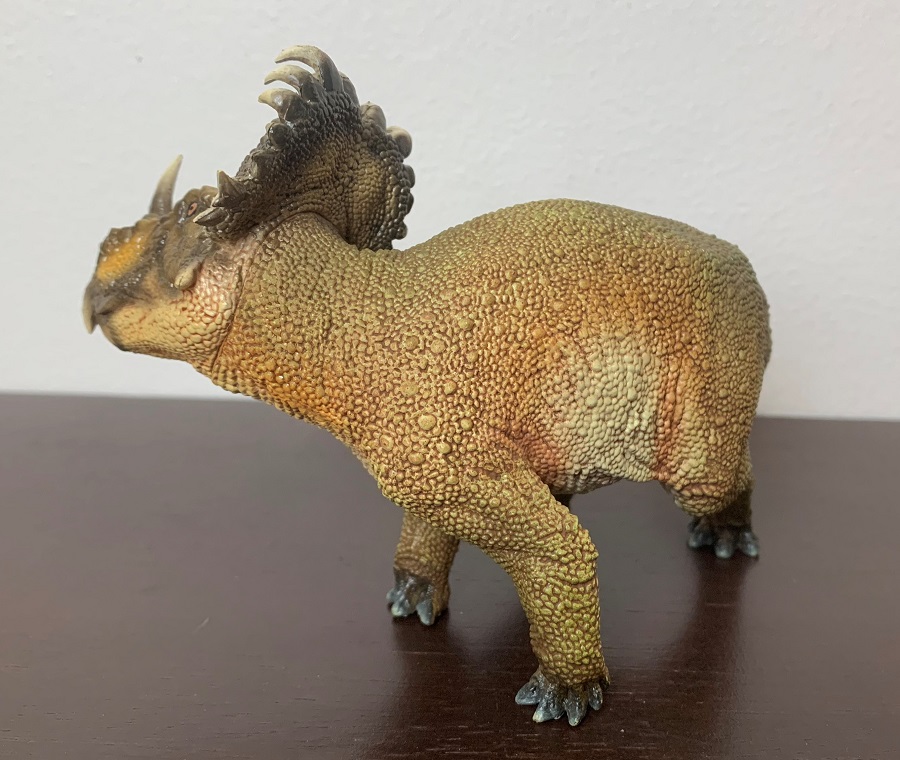
The head of A-Qi is sculpted with a short nasal horn and a series of smaller hornlets around the frill. The eight topmost hornlets are curved forward. Two larger horns are sculpted on the sides of the frill with their own smaller hornlet branching off. The horns are all exceptionally sharp, so parents beware. Compared to its Jurassic World counterpart it is easy to see just how exaggerated the movie’s animal was.
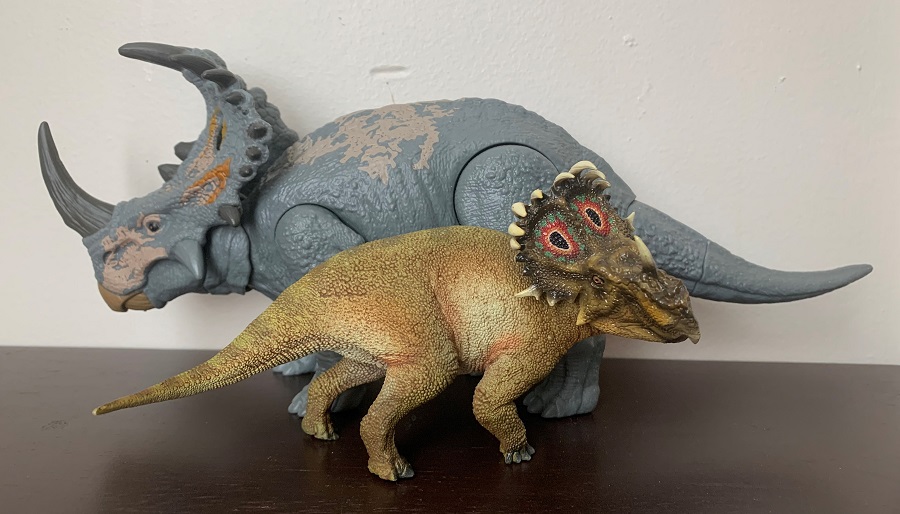
Ceratopsians lend themselves well to PNSO’s aesthetic, so larger scales and osteoderms are appreciated here. A-Qi is covered in small pebbly scales of varying sizes, with larger osteoderms scattered about. Larger, armored looking scales are sculpted around the face; on top of the snout, between the eyes, and up the center of the frill. The underside of the figure has crocodile-like belly scales with some smaller varying scales around the cloaca. I particularly like how the scales on the underside work their way up the neck and between the mandibles of the lower jaw.
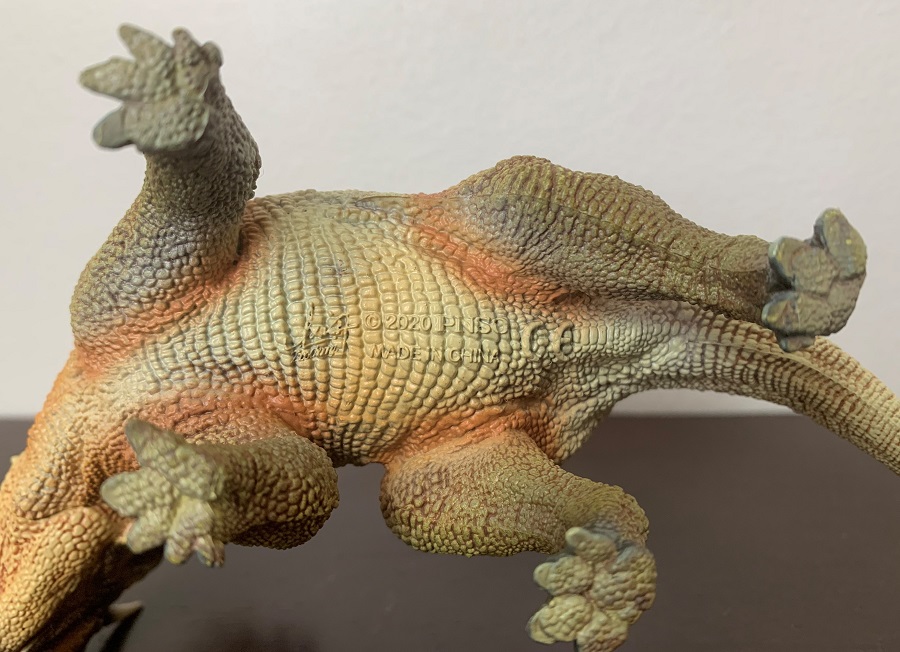
In addition to phenomenal scale detail there are also creases and skin folds present in appropriate places. On the right side of the neck there are abundant skin folds, due to the extreme direction the head is tilting, while the skin appears taught on the left side. The same is true for the legs, since they’re crunched closer together on the right side there are more skin folds present there. Connective tissue on the left hindlimb is stretched tight with the legs pushing the body hard towards the right.
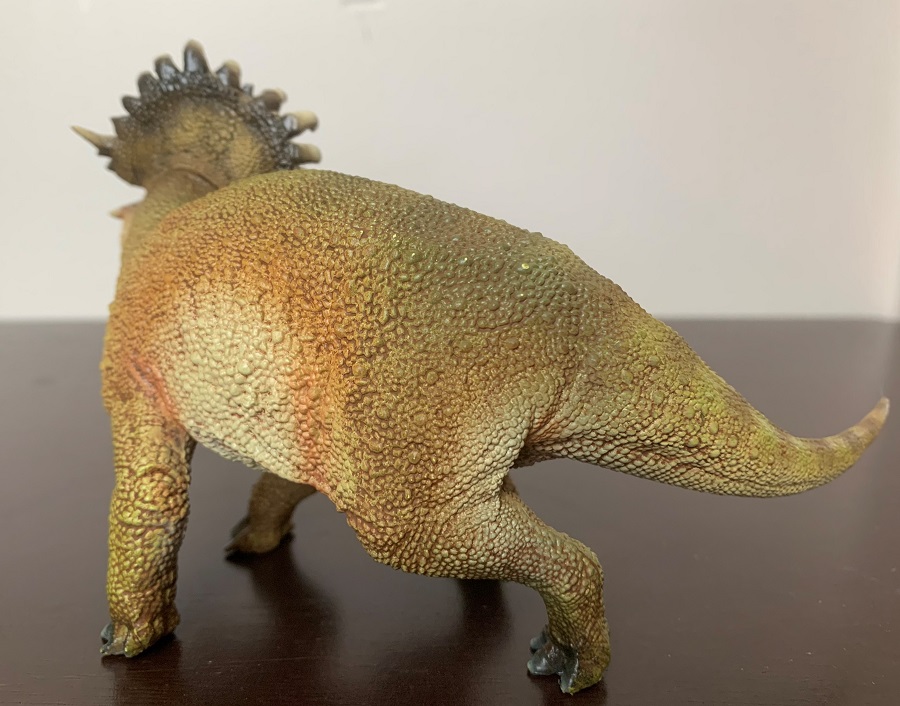
The flow of movement is all conveyed in a convincing and lifelike way. The only thing that might detract from that realism is the visible seam around the head, but it is really only visible on the left side. What’s really amazing are the fine details present in places you might not even look. On the beak, for example, there is a layered texture like what you would see on the beak of a parrot.
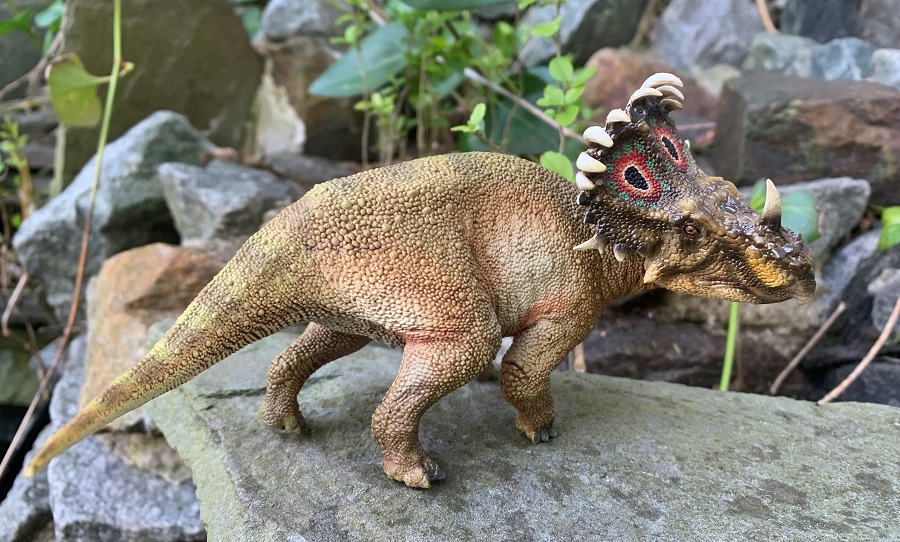
Despite being a more scientific approach to Sinoceratops there are still Jurassic World influences here, with the paintjob. It’s not by any means identical and certainly not off-putting but it still seems obvious to me. Simply put the figure is painted in blended green and brown tones with a lighter underside and colorful eyespots on the frill. In actuality, the paintjob is far more complex than that with the various colors blending together and additional colors popping up in the places where they do.
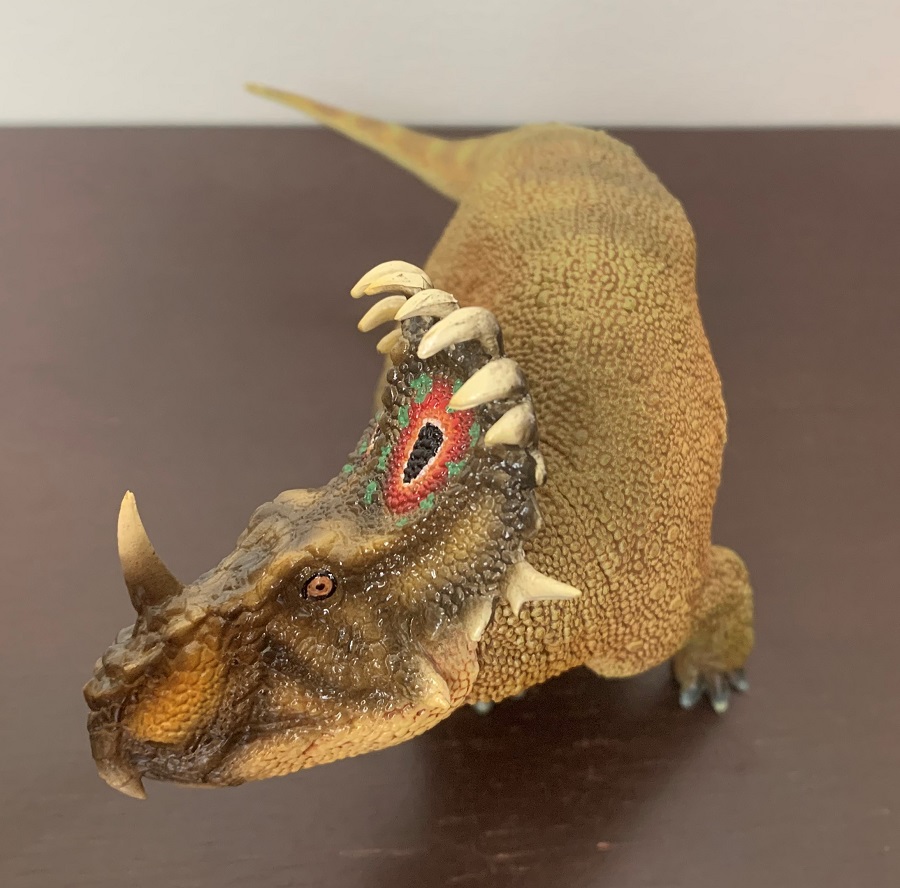
The predominantly green back has faint bands painted down its length that are subtle at first and become more apparent down the tail. Along the flanks the green fades to a brown, almost dull orange tone, which then blends into the cream underside. More than just blending together, the brown coloration also weaves itself between the scales on most of the body.

On the head there are multiple shades of green that follow the contours of the face and gradually fade at the base of the cream-colored horns and beak. The bulging nasal area is painted yellow, distinguishing that softer portion of anatomy from the rest of the skull. On the frill are elaborately painted eyespots consisting of sharply contrasting rings of red, orange, and white, with black coloration in the center. The outside of the eyespots are rimmed with emerald green spots. The eyespots are a particularly nice touch as most companies seem to ignore the visual aspect that ceratopsian frills likely had.

The entire head also has a glossy finish that makes it appear hard and keratinous. This would have been fine in certain portions, perhaps on the larger scales between the eyes and on the frill, but it is a bit overdone and makes the subtle coloration harder to appreciate. That is my only real criticism about the toy in general.

The PNSO Sinoceratops is my first mid-sized ceratopsian from the company but it certainly won’t be my last. For many years now I’ve only really focused on Safari’s ceratopsians but it’s nice to have another company producing equally fantastic sculpts, allowing me to diversify my collection. A-Qi is the definitive Sinoceratops that will be hard for any company to surpass, with phenomenal realism and one of the best paintjobs I’ve seen from PNSO thus far. That said, it does demand a higher price than it probably should, retailing on Amazon for $30.99. With a little shopping around, you can find it at a better value, and I bought mine without the packaging on Aliexpress for $21.99. No matter how you get it just make sure that you do, you won’t be disappointed.
Support the Dinosaur Toy Blog by making dino-purchases through these links to Ebay and Amazon. Disclaimer: links to Ebay.com and Amazon.com on the The Dinosaur Toy Blog are often affiliate links, when you make purchases through these links we may make a commission

This little guy became my favorite PNSO dino figure as soon as I held him in my hands (which is saying a LOT given how many quality figures PNSO has produced in the past 6 years). The symmetry of the frill, the angled sharpness of the horns and the “eye spots” on the frill all make it irresistible to the eye. The interesting, curved pose makes it stand out in any display. Beautiful. A+++++
This was my first mid-sized PNSO figure and I love it. It definitely made it into my personal GOAT selections.
Without a doubt the best of its kind from a scientific point of view and at an affordable price. His painting is good (it is in the mid-range of realism) and his sculpture is outstanding apart from all the size judging by the photographs is more than acceptable. Superb review.
A great and detailed read. Thanks for the good Review on this Figure. Comparisonshots are always a nice addition. I am surprised how well it goes next to the other Ceratopsians, that are not from PNSO. I mostly look at my Figures from a distance (Like most of us do, i guess), so it blends in very well.
Thank you and yes, I agree, it does display reasonably well with other ceratopsians of about the same size.
Great photography, great review. Thanks.
I believe this is PNSO’s 4th “mid range” ceratopsian, all of which are executed with their usual aplomb.
My single complaint, for lack of a better/gentler term, is that, apart from CollectA’s painfully overly stylized treatments (almost a signature, really,) other companies have conspicuously ignored the discovery of quills on Triceratops, IE maybe more of the family sported same. It seems kind of like ignoring the possibility/probability of feathers on certain other families a decade or so ago, or the “lizard in the chicken suit” treatment of raptors that has not yet gone completely out of vogue.
(Maybe if I grouse just a wee bit, that may change?) PNSO, for my money (literally) however, remains the high bar in “affordable” dinosaur figures.
You’re talking about the Lane specimen. From what I understand actual quills have not been discovered for Triceratops. What does exist are large tubercles with a hole in the center that MAY have held a quill, spike, or cluster of quills, but it’s all speculative. Anyway, I’ve heard talk of quills for years but nothing has been formally published about it so far. I would love it if someone made a shaggy Pachyrhinosaurus though, like the one painted by Mark Witton.
This is my favourite PNSO ceratopsian so far. Sure hope that rumoured Zhuchengtyrannus isn’t just a rumour; it’ll pair beautifully with A-Qi.
It’s my favorite too, but I’ll get the rest of them eventually. I would be really surprised if PNSO didn’t make a Zhuchengtyrannus. It’s a large Chinese tyrannosaur, they can’t ignore it for long.